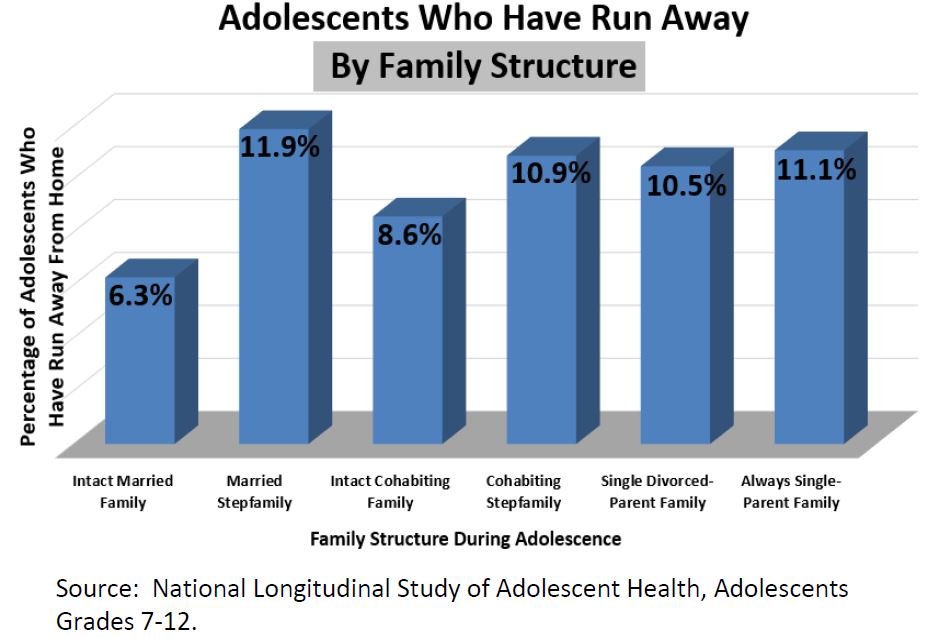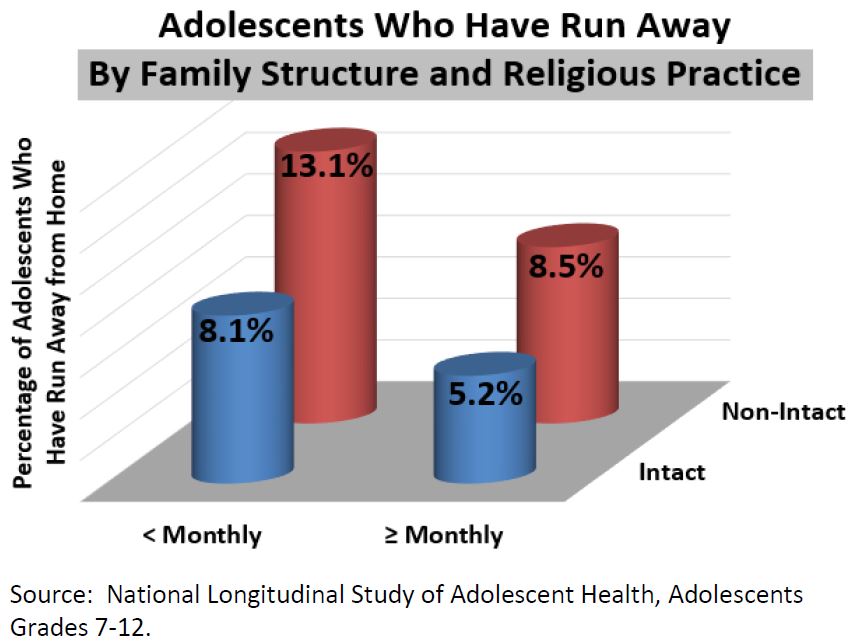Click Here to download “Adolescents Who Have Run Away by Family Structure and Religious Practice”
Adolescents Who Have Run Away by Family Structure and Religious Practice
Family Structure: Based on National Longitudinal Study of Adolescent Health, 6.3 percent of students in Grades 7-12 who lived with their married, biological parents had run away from home before. By contrast, 11.9 percent of adolescents who lived with a stepparent havd run away from home. In between were those who lived with two biological cohabiting parents (8.6 percent), those whose parents were divorced (10.5 percent), those who lived in a cohabiting stepfamily (10.9 percent), and those who lived with a single, never-married parent (11.1 percent). Religious Practice: According to the National Longitudinal Study of Adolescent Health, 6.4 percent of students in Grades 7-12 who worshipped at least weekly had run away from home. By contrast, 11.5 percent of students who never worshipped had run away from home. In between were those who worshipped one to three times a month (7.3 percent) and those who worshipped less than once a month (10.3 percent).
Religious Practice: According to the National Longitudinal Study of Adolescent Health, 6.4 percent of students in Grades 7-12 who worshipped at least weekly had run away from home. By contrast, 11.5 percent of students who never worshipped had run away from home. In between were those who worshipped one to three times a month (7.3 percent) and those who worshipped less than once a month (10.3 percent).
 Family Structure and Religious Practice Combined: Only 5.2 percent of adolescents who lived with both biological parents and worshipped at least monthly had ever run away from home. By contrast, more than 13.1 percent of adolescents who worshipped less than monthly and came from single-parent or reconstituted families had run away. In between were those in non-intact families who worshipped at least monthly (8.5 percent) and those who lived with both biological parents and worshipped less than monthly (8.1 percent).
Family Structure and Religious Practice Combined: Only 5.2 percent of adolescents who lived with both biological parents and worshipped at least monthly had ever run away from home. By contrast, more than 13.1 percent of adolescents who worshipped less than monthly and came from single-parent or reconstituted families had run away. In between were those in non-intact families who worshipped at least monthly (8.5 percent) and those who lived with both biological parents and worshipped less than monthly (8.1 percent).
 Related Insights from Other Studies: Several other studies corroborate the direction of these findings. Having analyzed delinquency data from the National Longitudinal Study of Adolescent Health, Lela McKnight and Ann Loper of the University of Virginia reported that single-parent status was a significant risk factor for adolescent female delinquency while religious belief was a significant resiliency factor.[1]
Wendy Manning and Kathleen Lamb of Bowling Green State University also found that adolescents who lived with both biological parents and were more religious were less likely to be delinquent.[2]As the evidence indicates, religious attendance and the intact married family are a powerful tandem of effective guardians against runaway adolescents.
[1] Lela Renee’ McKnight and Ann Booker Loper, “The Effect of Risk and Resilience Factors on the Prediction of Delinquency in Adolescent Girls,” School Psychology International, vol. 23 (2002): 186-198. The delinquency measures included running away from home.
[2] Wendy D. Manning and Kathleen A. Lamb, “Adolescent Well-Being in Cohabiting, Married, and Single-Parent Families,” Journal of Marriage and Family, vol. 65 (2003): 876-893. The delinquency measures included running away from home.]]>
Related Insights from Other Studies: Several other studies corroborate the direction of these findings. Having analyzed delinquency data from the National Longitudinal Study of Adolescent Health, Lela McKnight and Ann Loper of the University of Virginia reported that single-parent status was a significant risk factor for adolescent female delinquency while religious belief was a significant resiliency factor.[1]
Wendy Manning and Kathleen Lamb of Bowling Green State University also found that adolescents who lived with both biological parents and were more religious were less likely to be delinquent.[2]As the evidence indicates, religious attendance and the intact married family are a powerful tandem of effective guardians against runaway adolescents.
[1] Lela Renee’ McKnight and Ann Booker Loper, “The Effect of Risk and Resilience Factors on the Prediction of Delinquency in Adolescent Girls,” School Psychology International, vol. 23 (2002): 186-198. The delinquency measures included running away from home.
[2] Wendy D. Manning and Kathleen A. Lamb, “Adolescent Well-Being in Cohabiting, Married, and Single-Parent Families,” Journal of Marriage and Family, vol. 65 (2003): 876-893. The delinquency measures included running away from home.]]>
